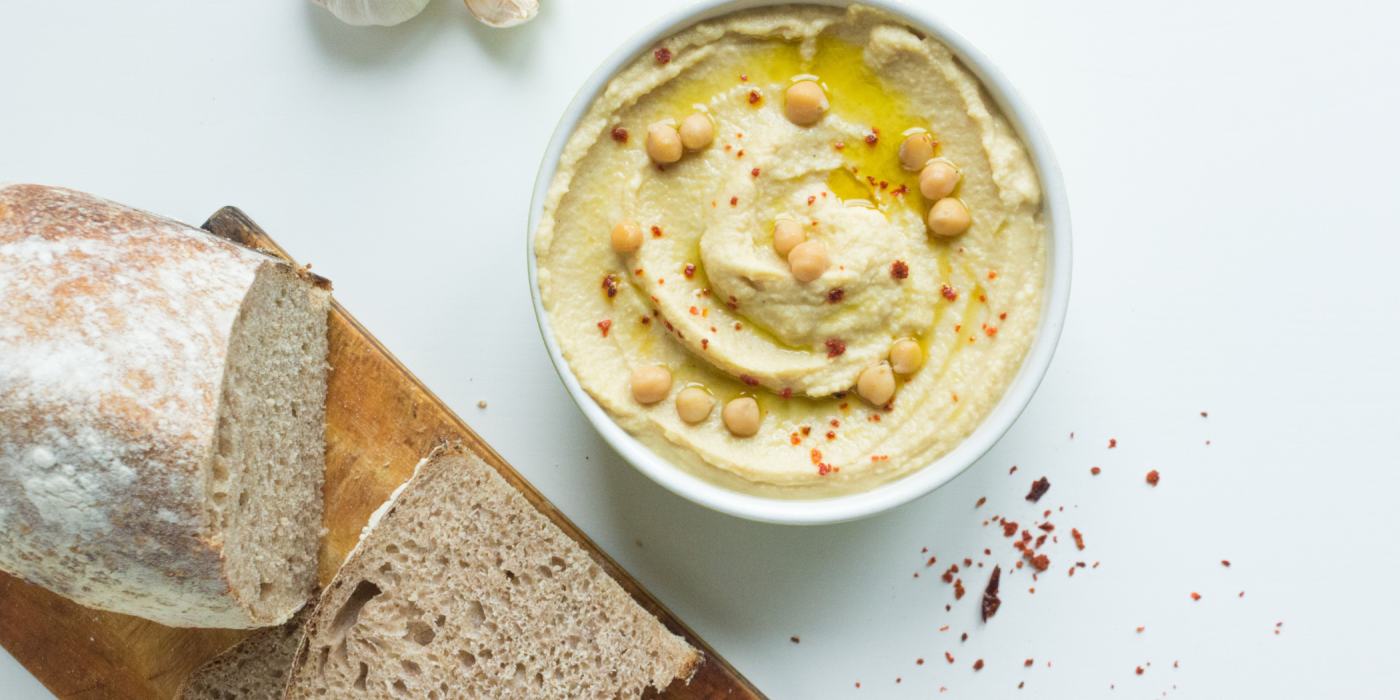How to Make Hummus: A Nutritious Delight with a Few Surprising Facts

Hummus, a delightful blend of chickpeas, tahini, olive oil, lemon juice, and spices, has captivated palates worldwide. Let's learn more about it, from its calorie content to its benefits for certain health conditions.
Hummus, the creamy, savoury, and delicious spread, has captured global attention due to its versatility and health benefits. Today, we will explore a range of hummus recipes, each delivering unique flavours and benefits. Whether you're a hummus enthusiast or a curious beginner, this collection of recipes promises a delightful culinary experience.
Hummus Recipe: Red Pepper
Our first variant adds a sweet and smoky dimension to the classic hummus with roasted red pepper. This recipe is as colourful as it is flavorful, perfect for a vibrant party spread.
Ingredients:
- 1 cup canned chickpeas
- 1/4 cup fresh lemon juice
- 1/4 cup tahini
- 1 garlic clove, minced
- 2 tablespoons olive oil
- Salt to taste
- 1 medium-sized red bell pepper, roasted and peeled
Directions:
- Blend tahini and lemon juice in a food processor for a minute. Add the rest of the ingredients and process until smooth.
- Adjust the salt to taste and serve with a drizzle of olive oil.
Hummus Recipe: Simple
Next, we go back to basics with a straightforward hummus recipe that highlights the traditional flavours. This classic recipe is an all-time favourite and a great starting point for hummus novices.
Ingredients:
- 1 cup canned chickpeas
- 1/4 cup fresh lemon juice
- 1/4 cup tahini
- 1 garlic clove, minced
- 2 tablespoons olive oil
- Salt to taste
Directions:
- Blend tahini and lemon juice in a food processor for a minute. Add the rest of the ingredients and process until smooth.
- Adjust the salt to taste and serve.
Hummus Recipe: Low Fat
For those keeping a keen eye on their caloric intake, this low-fat hummus recipe is a great choice. By substituting tahini with Greek yoghurt, we can maintain creaminess while reducing the fat content.
Ingredients:
- 1 cup canned chickpeas
- 1/4 cup fresh lemon juice
- 1/4 cup low-fat Greek yoghurt
- 1 garlic clove, minced
- 1 tablespoon olive oil
- Salt to taste
Directions:
- Blend Greek yoghurt and lemon juice in a food processor for a minute. Add the rest of the ingredients and process until smooth.
- Adjust the salt to taste and serve.
Hummus Recipe: From Dried Chickpeas
This recipe is for those who prefer to prepare their hummus from scratch. Using dried chickpeas involves a bit more effort, but the flavour and texture pay-off is considerable.
Ingredients:
- 1 cup dried chickpeas, soaked overnight and cooked
- 1/4 cup fresh lemon juice
- 1/4 cup tahini
- 1 garlic clove, minced
- 2 tablespoons olive oil
- Salt to taste
Directions:
- Blend tahini and lemon juice in a food processor for a minute. Add the rest of the ingredients and process until smooth.
- Adjust the salt to taste and serve.
Hummus Recipe: Spicy
If you're a fan of heat in your meals, this spicy hummus recipe is for you. The addition of cayenne pepper gives this hummus variant a punch that pairs well with crunchy veggies or pita bread.
Ingredients:
- 1 cup canned chickpeas
- 1/4 cup fresh lemon juice
- 1/4 cup tahini
- 1 garlic clove, minced
- 2 tablespoons olive oil
- Salt to taste
- 1/2 teaspoon cayenne pepper (adjust to taste)
Directions:
- Blend tahini and lemon juice in a food processor for a minute. Add the rest of the ingredients and process until smooth.
- Adjust the salt and cayenne pepper to taste and serve.
Hummus Recipe: Flavors
Lastly, we explore the virtually limitless possibilities for flavouring your hummus. Experiment with adding ingredients such as sun-dried tomatoes, olives, cilantro, cooked sweet potato, or even beetroot. These creative additions can transform your hummus into a gourmet delight.
Unveiling the Health Benefits of Hummus
Hummus, a Mediterranean dip that has gained global popularity, is not just a delicious addition to your meals but a nutritional powerhouse as well. Let's dive into the various facets of hummus nutrition, from its calorie content to its implications for particular health conditions.
Hummus Nutrition
Hummus is primarily made from chickpeas, also known as garbanzo beans. Chickpeas are rich in proteins, essential for tissue repair and growth. They're also a great source of vitamins and minerals, like folate, iron, and phosphorus.
Tahini, another critical ingredient in hummus, is made from sesame seeds and is high in healthy fats, antioxidants, and vitamin E. Olive oil, yet another component, is rich in heart-healthy monounsaturated fats.
Hummus Calories
Despite being nutrient-rich, hummus is relatively low in calories. A standard serving of hummus, which is roughly two tablespoons, contains around 70-80 calories. Keep in mind that adding extra ingredients like roasted red peppers or sun-dried tomatoes may alter this count slightly.
Hummus Fiber
One of the standout nutritional aspects of hummus is its fibre content. A single serving provides around 2 grams of dietary fibre. Consuming fibre-rich foods like hummus can aid in maintaining a healthy digestive system and help in managing your weight.
Is Hummus Low FODMAP?
FODMAP stands for Fermentable Oligosaccharides, Disaccharides, Monosaccharides, and Polyols. These are certain types of carbohydrates that aren't absorbed properly in the gut and can trigger symptoms in people with irritable bowel syndrome (IBS).
Traditional hummus, made with chickpeas, is not low FODMAP. Chickpeas contain oligosaccharides, a type of carbohydrate that can cause discomfort in some people. However, a low FODMAP version of hummus can be made using other ingredients, such as roasted zucchini or red bell peppers.
Hummus for Breakfast
Hummus is a fantastic addition to your breakfast menu. Thanks to its protein content and healthy fats, it can provide a satiating and energy-boosting start to your day. Consider spreading hummus on your whole-grain toast or mixing it into a breakfast wrap for a flavorful, nutritious meal.
Hummus When Pregnant
Hummus is generally safe and beneficial to consume during pregnancy. The folate present in chickpeas is particularly important for pregnant women, as it plays a vital role in the development of the baby's neural tube. However, it's crucial to ensure that the hummus is fresh and well-stored to avoid the risk of foodborne illnesses.
Hummus: Good for Diabetics
Hummus can indeed be a part of a healthy diet for people with diabetes. Its high fibre content and low glycemic index mean it's digested slowly, preventing spikes in blood sugar levels. Moreover, the healthy fats in hummus can help improve heart health, which is particularly important for people with diabetes.
Unveiling the Wonders of Hummus: From Preparation to Consumption
Hummus is a delicious, nutritious spread that has found its way into kitchens worldwide. Whether you're new to hummus or a seasoned hummus maker looking for new ideas, this blog post will provide some helpful insights.
Hummus Tips
Making the perfect hummus requires attention to a few key details. Here are some tips for the best results:
-
Quality of Ingredients: The taste of your hummus significantly depends on the quality of your ingredients. Choose the best quality tahini and freshest chickpeas you can find.
-
Smoothness: For smoother hummus, peel the chickpeas after boiling. This might be time-consuming, but the resulting texture is worth it.
-
Adjust to Taste: Hummus is flexible. Don't hesitate to adjust the garlic, lemon juice, tahini, and salt to your preference.
-
Ice-cold Water: While blending your hummus, add some ice-cold water. This helps to make it extra creamy.
Hummus Przepis
Przepis is the Polish term for recipe. Here's a classic hummus recipe:
Ingredients:
- 1 cup canned chickpeas
- 1/4 cup fresh lemon juice (1 large lemon)
- 1/4 cup well-stirred tahini
- 1 small garlic clove, minced
- 2 tablespoons extra-virgin olive oil, plus more for serving
- 1/2 teaspoon ground cumin
- Salt to taste
- 2 to 3 tablespoons water
- Dash of ground paprika, for serving
Directions:
- Blend tahini and lemon juice in a food processor for a minute.
- Add the rest of the ingredients and process until smooth.
- Adjust salt to taste, and more water if necessary to achieve a smooth, creamy texture.
- Place in a serving dish, drizzle with olive oil, and sprinkle with paprika before serving.
Hummus with Dried Chickpeas
Using dried chickpeas can elevate the taste of your hummus, although it requires a bit more time. Soak the chickpeas overnight and then cook them until soft. You can then proceed with the standard recipe.
Hummus: How to Eat
Hummus is a versatile spread that can complement a variety of dishes. Here are a few suggestions:
- Dip: Use hummus as a dip for vegetables, pita bread, or chips.
- Spread: Spread hummus on your sandwiches or wraps.
- Salad Dressing: Mix hummus with a bit of vinegar and olive oil to create a unique salad dressing.
- Cooking Ingredient: You can also use hummus in your cooking. For instance, it can replace cream to create a vegan pasta sauce.
Hummus Types
There are several types of hummus you can enjoy, each offering a unique flavour:
- Classic Hummus: This is a traditional recipe made with chickpeas, tahini, olive oil, lemon juice, garlic, and salt.
- Roasted Red Pepper Hummus: This variant includes roasted red peppers for a smokey, sweet flavour.
- Black Bean Hummus: Replacing chickpeas with black beans creates a different flavour and texture profile.
- Beet Hummus: Adding roasted beets to your hummus not only gives it a vibrant colour but also an earthy flavour.
- Spicy Hummus: Add jalapenos, cayenne pepper, or hot sauce to your hummus for a spicy kick.
How Many Carbs in Hummus?
Hummus is a good source of complex carbohydrates. A two-tablespoon serving of hummus contains approximately 4 grams of carbohydrates. The majority of these carbs come from chickpeas, which offer slow-releasing energy to keep you satiated.
In wrapping up, hummus is indeed a culinary gem that seamlessly blends taste, nutrition, and versatility. Whether you make it from canned or dried chickpeas, hummus serves as a delicious spread, dip, or ingredient in your cooking. With numerous types and flavours to explore, your hummus journey needs never be dull. Don't forget the nutritional benefits, too, with a balance of proteins, healthy fats, and complex carbs in every serving.
So, whether you're a first-time hummus maker or a seasoned pro looking for new ideas, remember that making hummus is more of an art than a science. Feel free to experiment with flavours, adjust to your taste, and most importantly, enjoy the process. Hummus truly is a celebration of simple ingredients coming together to create something remarkable. Happy hummus making!
I do hope you have enjoyed this article and hope that you will subscribe to my newsletter so you can get the latest information about all things naturally relaxing.
Stay in touch, join the Naturally Relaxing Newsletter
Newsletter Signup
Post Your Comments
or post as a guest
Be the first to comment.
Latest articles in Food

Hot Cross Buns This Easter: A Timeless Tradition of Baking and Sharing

Chocolate Krispie Cakes for Easter: A Simple, Festive Treat for All

2023 Christmas Culinary Delights: Recipes for the Ultimate Festive Feast

Embrace Autumn with the Best Pumpkin Spice Recipes in the UK

Turning Pumpkin Carvings into Pumpkin Pie: A British Culinary Tradition






